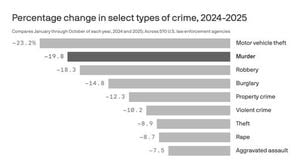After a record-setting 43-day federal government shutdown, the nation is catching its breath as agencies reopen, workers return, and the ripple effects begin to show. The shutdown, which ended on November 14, 2025, left more than 11,000 flights canceled and chaos in airports across the country, according to ABC News. But the disruption stretched far beyond travel, touching nearly every corner of American life—from schools and food assistance to state budgets and federal programs.
President Donald Trump signed the bill to reopen the government, funding operations through January 30, 2026, as reported by Education Week and EdWeek Market Brief. This legislation not only reversed thousands of federal employee layoffs that began in early October but also brought hundreds of U.S. Department of Education staff back to their posts. Yet, as Rachel Gittleman, president of the union representing Education Department staff, told EdWeek, “We have no confidence that the U.S. Education Department will follow the terms of the continuing resolution or allow the employees named in October firings to return—or even keep their jobs past January.”
For K-12 schools, the shutdown's end offered a breath of relief, but not a return to business as usual. Districts dependent on federal funding had seen payments and programs delayed or halted, creating a climate of uncertainty that cooled spending and planning. Now, with the government’s doors open, school systems are scrambling to catch up, even as questions linger about what happens after the current funding bill expires in January.
The impact of the shutdown was especially acute for states already navigating major federal changes. As Stateline reported, many states are unsure if or how they’ll be reimbursed for costs incurred to keep federal programs running. During the shutdown, states took varied approaches to the Supplemental Nutrition Assistance Program (SNAP): some issued partial payments, while others, like California, sent emergency aid to food banks. California dedicated $80 million in state funds and even deployed the National Guard to food banks, while Virginia launched a temporary state-level version of SNAP.
Even with the reopening of the government and restoration of SNAP aid, challenges remain. The One Big Beautiful Bill Act, signed by President Trump in July 2025, ties SNAP funding to state error rates and mandates deep cuts to social service programs—including Medicaid and SNAP itself. States must now pay a greater share of SNAP’s administrative costs, and eligibility changes could lead to millions losing benefits. As Crystal FitzSimons, president of the Food Research & Action Center, told Stateline, the shutdown “highlighted the importance of SNAP and how ‘untenable’ many of the upcoming changes will prove for states.”
The shutdown’s end also brought with it a promise of reimbursement for states’ emergency expenditures. The reopening legislation states that states shall be reimbursed for expenses “that would have been paid” by the federal government during the shutdown. But as Marcia Howard, executive director of Federal Funds Information for States, explained to Stateline, the fine print is unclear. States that sent money through existing federal programs like SNAP may be more likely to be made whole than those that funneled aid through alternative means. “This administration is really more holding states’ feet to the fire perhaps than other administrations have. So I think they’ll be less permissive in who and how they reimburse,” Howard said.
Meanwhile, states like Maryland are bracing for further fallout. In late October, Democratic Governor Wes Moore declared an emergency and allocated $10 million to food banks, later deploying $62 million directly to SNAP recipients. Maryland expects federal reimbursement for SNAP expenditures, but state budget officials are already projecting a $1.4 billion budget gap—not including the possible long-term effects of the shutdown. State Senator James Rosapepe, chair of the joint Spending Affordability Committee, voiced his concerns to Stateline: “We’re less than a year into the administration, and the effects of things they’ve already done don’t seem to have flowed through yet to the data that we have, which leads me to believe that the worst is yet to come.”
Education policy also saw major developments outside the shutdown’s shadow. Pennsylvania, after a four-month stalemate, finalized a $50.1 billion state budget on November 12, 2025, with over $900 million in new funding for pre-K-12 public education. This includes a $565 million boost in adequacy funding and $40 million more for special education, as reported by EdWeek Market Brief. The budget also reforms cyber-charter tuition, projecting $175 million in statewide savings. For districts that had to tap reserves or postpone spending during the budget delay, the new funding offers hope—though the late timing may still slow deals and force fiscal-year adjustments.
In Texas, state education leaders are preparing to review and potentially vote on instructional materials as part of the updated 2025 adoption process. The Texas Education Agency has already issued a call for 2026 materials, with a deadline of October 31, 2025. Under the new model, districts get a $40-per-student incentive for adopting state-approved materials—a significant lever in a state serving over 5 million students. However, the process has become more rigorous, with stricter standards and a new rejected list banning certain materials from public schools and charters. As EdWeek Market Brief notes, the changes could reshape the curriculum landscape for years to come.
Beyond education and food assistance, the shutdown and its aftermath have exposed deeper structural changes in the relationship between state and federal governments. Eric Schnurer, founder of Public Works, told Stateline that “the ground is shifting under their [states’] feet even as this goes on.” Since taking office, the Trump administration has stripped states and cities of billions in funding for education, infrastructure, and energy, while the One Big Beautiful Bill Act imposes new administrative burdens and spending cuts. William Glasgall, public finance adviser at the Volcker Alliance, pointed out that federal tax code changes will cost some states hundreds of millions in revenue, forcing them to rethink their own tax structures.
Lisa Parshall, a political science professor at Daemen University, summed up the ongoing strain: “There’s a delay of services, there’s a diminishment of capacity and partnership, and those things might be harder to quantify when you’re talking about what is the cost of the shutdown. But I think those are real costs.” She warned that even with the shutdown over, “things are not going to go back to ‘normal.’”
As the country moves forward, the true cost of the shutdown—and the new federal policies it spotlighted—will become clearer in the months ahead. For now, states, schools, and families are left to navigate a changed landscape, hoping that the next crisis won’t come too soon.





